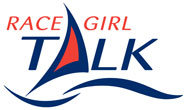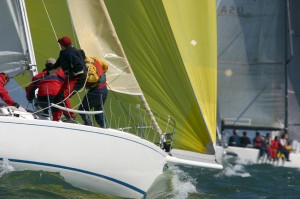Sailboat Racing Trim — Part 10
In Chapter 10 of his book Racing Trim, Bill Gladstone talks about asymmetric spinnaker handling. The following post shows a short summary of that chapter.
Asymmetric Spinnaker Handling
For asymmetric spinnakers, two sheets are attached to the clew. A tack line controls the tack and holds it against the sprit when sail is hoisted. An asymmetric spinnaker doesn’t use a guy.
Asymmetric Spinnaker Sets
For a bear away set, the pole is extended first. Then, the tack line pulls the sail to the end of the pole and the sail is hoisted. The sheet can be used to pull the sail aft.
A jibe set is pretty similar to a bear away set. However, the spinnaker is set up to windward. Make sure that the spinnaker is in front of the spreaders before jibing the main.
Asymmetric Spinnaker Jibes
Astmmetric jibes can be done inside or outside the boat. For inside jibes, the clew stays inside the luff and the sheets go directly to the clew. For outside jibes, the clew goes outside all the way around the front of the boat. So, the sheets need to run that extra distance to pull the clew all the way around the outside.
Troubleshooting
- If the boat is turned too quickly, the sail will backwind and it will be really difficult to pull the rest of the way around the boat. If the boat turns too slowly, the spinnaker won’t get enough air and it will collapse.
- If the old sheet is released before the new one is taken up, the clew will blow out in front of the luff. This will also be hard to pull around, and could easily result in a twist.
- The sail needs to be trimmed quickly, but then eased so that it can fill. If this doesn’t happen, the boat could be slow in light air or broach in heavy air.
Outside jibes
- Remember, the speed of the turn must still match the speed of the trimming. It takes more work to get the clew pulled around on outside jibes than inside jibes.
- Be prepared for the helm to load up as soon as the sail fills. Give a big ease on the sheet and pull down on the helm to prevent rounding up.
- Wraps on the head stay mean that the turn was quicker than the sail trimming. If the boat goes out of control on the jibes, ease the old sheet quicker.
Asymmetric Spinnaker Takedowns
Reaching takedowns
- Leeward drop — square away to a broad reach on the drop and make sure that the foot of the sail doesn’t go into the water.
- Weather drops — a takedown line can also be used to help get the spinnaker pulled down.
- For all of these takedowns, approach high and drive down if it’s possible. Don’t hesitate to put lots of crew members on the take down to help gather the sail.
Running takedowns
- Jibe drop — Sometimes the Jibe drop is also known as a “Mexican.” For this type of a drop, round the mark a few boat lengths upwind, move the boat to a run, and use the lazy sheet to pull the sail to the deck. This type of a takedown is helpful because the sail is blown onboard making it easier to stow.
- Windward takedown –This type of a takedown is nice because it leaves the spinnaker ready for the next set. Take the windward sheet and drag the clew around the forestay. Release the tack line and drop the halyard.
- Again, approach high and drive down if it’s possible. Don’t hesitate to put lots of crew members on the take down to help gather the sail.
Asymmetric Spinnakers on Conventional Boats
In this type of a set up, the spinnaker pole is usually carried low and forward (hmmm….sounds like this resembles a sprit).
On the hoist, the pole is moved back a bit, but not very much. Again, I’m thinking of the pole similar to the sprit. Use outside jibes if you’re flying an asymmetric spinnaker on a conventional boat. Stretch and blow, and jibe drops are all types of takedown that can be used to drop the asymmetric spinnaker here.
This is the tenth in a series of posts based on Bill Gladstone’s book Racing TRIM from the North U. Series. Periodically, I post about a chapter or two. This will be my short summary of what I’ve read. You can read the posts to get my abbreviated summary; or you could read through the books with me. Your comments can help point out what you find most interesting, or even poke fun at what I do and don’t know. If you are interested in getting this book, you can find it in the online store section of NorthU.com for $25.


